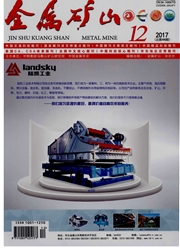

 中文摘要:
中文摘要:
针对地质构造区域煤层开采容易发生冲击地压的情况,建立了煤岩组合体力学模型,研究了煤厚变化对超前支承压力分布特征和能量演化规律的影响,揭示了煤厚变异区煤层开采冲击地压发生的力学机制。研究表明:煤厚变薄区的原岩应力比变厚区大,煤厚减小率或岩煤弹性模量比越大,应力变化梯度越大;工作面由厚向薄回采,超前支承压力呈"双峰值"分布,而工作面由薄向厚回采,超前支承压力呈"单峰值"分布;冲击地压发生时,工作面由厚向薄回采,第2峰值应力区内形成高能区会阻碍能量向煤壁深部传递,产生的冲击能量将主要向巷道或工作面临空面释放,而工作面由薄向厚回采,冲击能量可向煤壁深部转移,冲击影响范围小。现场案例分析及工程实践表明,工作面由薄向厚回采更有利于防冲。
 英文摘要:
英文摘要:
Rock burst is prone to easily occur during mining in the geological structural area. Thus,the mechanical model of coal-rock combination is established,the influences of coal thickness variation on the distribution characteristics of abutment pressure and the evolution law of impact energy are studied,and the rock burst's mechanism of mining in the variable region of coal thickness is revealed. Results show that the in-situ stress in the thinning area is larger than that in the thickening area,and the stress gradient increases with the increase of coal thickness reduction rate or elastic modulus ratio between rock and coal. When mining from thick to thin seam,the abutment pressure shows a"double peak"distribution,but when mining from thin to thick seam,the abutment pressure shows a "single peak"distribution. When mining from thick to thin seam,the high-energy area formed by the second peak stress area will hinder the energy from transmitting into the deep coal wall,which will cause the impact energy mainly release into roadways or working faces,but when mining from thin to thick seam,the impact energy can transmit into the deep coal wall,and the disaster's influencing scope is small. Field case analysis and field application show that mining from thinto thick seam is advantageous to control the rock burst.
 同期刊论文项目
同期刊论文项目
 同项目期刊论文
同项目期刊论文
 期刊信息
期刊信息
